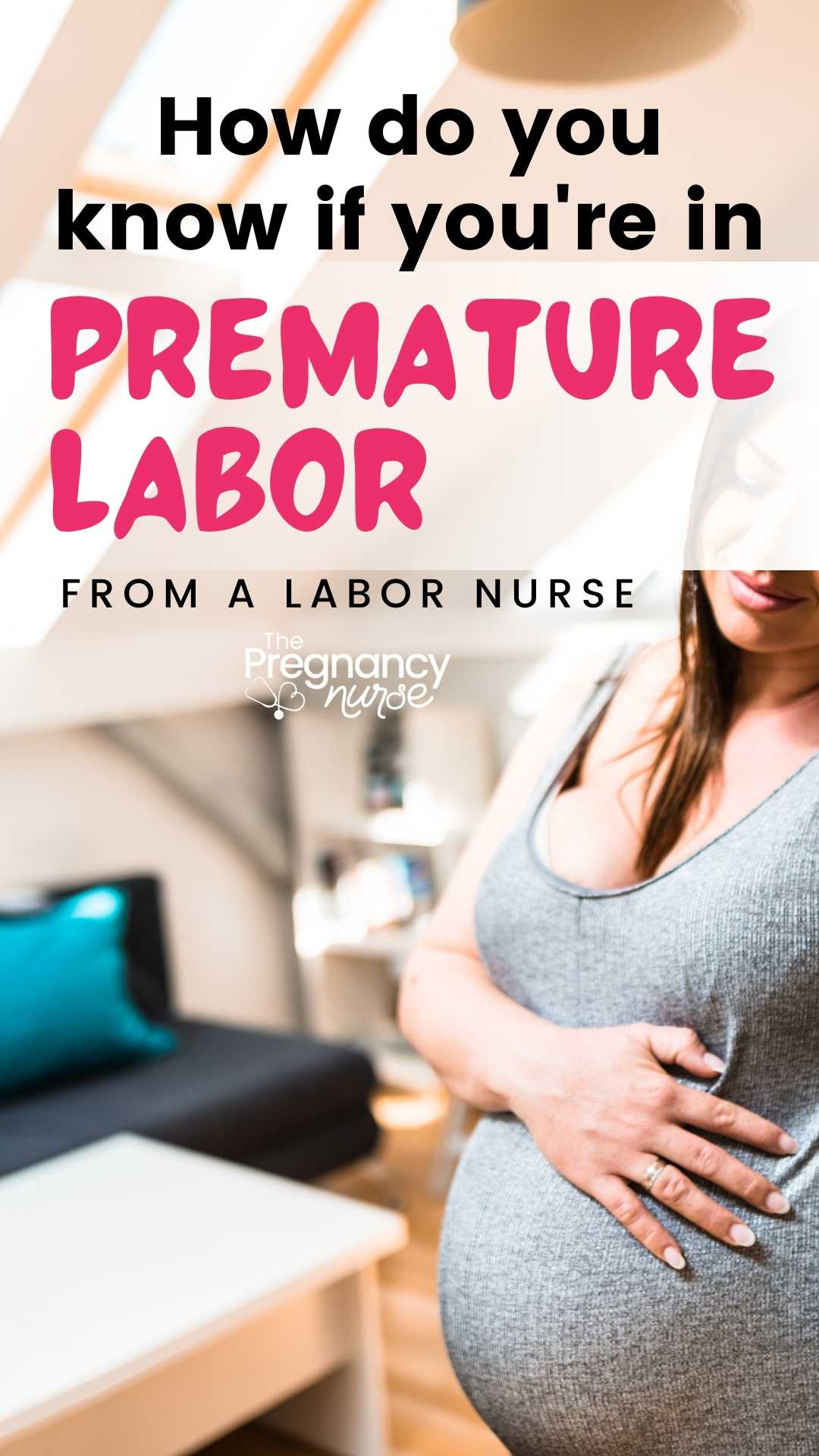At around the 34th week of pregnancy, you might be wondering when labor will start. It’s normal to start thinking about labor and delivery as your due date approaches. Here are some signs that labor might be starting.

But first, how do I know all of this? Hi — I’m Hilary — The Pregnancy Nurse 👩⚕️. I have been a nurse since 1997 and I have 20 years of OB nursing experience, I am also the curly head behind Pulling Curls and The Online Prenatal Class for Couples. 🩺 I have helped hundreds of moms in preterm labor, and I’ve helped thousands of moms decide if they are in labor, so I’m a good resource in this area.
And, labor isn’t just contractions — it’s so confusing I made a mini course (takes about 20 minutes) called Labor Made Easy that explains what you should be watching for — and all the different signs and symptoms that there are.
What is Premature Labor?
Premature labor is when labor occurs before the baby is full-term. A full-term baby is usually born around 40 weeks. Babies born before the 37th week of pregnancy are considered premature.
Premature labor can happen because of a problem with the uterus or cervix.
Anatomy Lesson: The uterus is the muscular organ that holds the baby during pregnancy. The cervix is the lower, narrow end of the uterus that opens into the vagina. As the baby passes through the cervix it causes the cervix to open (called cervical dilation).
If premature labor occurs, it could result in premature birth. However, some people do have contractions that don’t result in premature birth, and we’ll talk more about that later!
Oh, and grab my hospital packing list before we get too into this:
What Are the Labor Signs at 34-Week Pregnancy?
While these are definitely not ALL the signs of labor at 34 weeks of pregnancy, here are a few symptoms of preterm labor (be sure to talk with your provider about what YOU should be watching for based on your own specific needs):
The main difference between signs at 34 weeks vs late pregnancy is that your’e watching for earlier signs. It isn’t as important that you’re having some low back pain at 38 weeks (becuase, frankly — towards the end it isn’t as important), but at 34 weeks (or earlier) it could be a bigger deal.
Uterine Contractions
These are your uterus squeezing on the baby. Ultimately, it hopes to squeeze it down into the birth canal, but not all contractions are strong enough to do that. Some don’t really progress labor, which are called Braxton Hicks contractions — we will talk more about those in a bit as well.
Often, early contractions feel very similar to your period starting. Cramping in your lower abdomen, a “pelvic fullness” or pelvic pressure and sometimes some lower back pain. If you have any question about what your feeling, it is a good idea to contract your provider.
Loss of mucus plug
Your mucus plug is a collection of cells, mucus (surprise!) and blood that have collected in the vagina and somehow your body creates a sort of “cork” at the end of your cerivx.
It helps keep anything bad out of the uterus and possibly the amniotic fluid. It’s a protective mechanism.
When your cervix starts to open up this “plug” falls out. Think of it as the top of a corked bottle — if top of the bottom started to widen, the cork would easily slip out.
Most often you’ll see this in the toilet after you use the restroom.
While this is certainly not a definitive sign of labor, it is somewhat of a sign that your cervix is doing something. Now, your body can actually re-create this plug — so it’s not a huge issue. But it is something you should mention to your doctor at your next visit.
Or, if you see this sign with some of these other signs (like contractions) it would be worth a call to them (and if you can’t get hold of them, possibly going to labor and delivery).
BTW if you’re not even sure how to count how far contractions are apart — learn more in here.
Bloody show
This sounds horrible, but it’s actually just vaginal bleeding. Honestly, any amount of bleeding at 34 weeks is likely something I’d mention to my provider. Small amounts of spotting aren’t unusual after a vaginal exam or sexual intercourse due to the increased blood flow in the area, but if you have any concern over bleeding, you need to contact your doctor.
As your cervix opens, it sometimes bleeds — that is normally what causes this.
However, as I said before, any amount of bleeding can be a cause for concern, and if it’s any more than small bits of spotting you should call your provider and see what they recommend to do.
Fun Fact: Extreme fatigue can be a sign of labor too!
Rupture of membranes
Your baby is in a bag of water (called the amniotic sac), surrounded by amniotic fluid. At some point that bag of water can break. If it breaks before 36 or 37 weeks it’s called premature rupture of membranes.
It can be hard to tell if your water broke or if you peed, but if you think your water broke, and you’re just 34 weeks, call your provider. There is an easy test they can use called Amnisure to check and see if it’s amniotic fluid (or pee, because they’re easy to mix-up).
I have a post on the signs that your water may break soon.
If your water breaks you do need to head into the hospital as they will need to monitor the baby. There is an increased chance of infection in your uterus and around the baby the longer your water is broken.
If you have any of these signs of premature labor you’ll want to contact your provider. And no matter how far along you are, be sure to ask your provider what signs of preterm labor you should be watching for at home.
If you’re confused as to if your water broke, I have a quiz to tell if you broke your water or peed your pants.
What are Braxton Hicks contractions?
This is a good question, and this can be confusing.
Braxton Hicks contractions are known by a few names:
- Practice contractions
- False labor
The main thing that identifies these is that they aren’t pushing the baby through the cervix into the birth canal.
That doesn’t mean they’re not painful, or bothersome. It just means they’re not pushing the baby into the birth canal.
There is a test called Fetal Fibronectin that the hospital (and some doctors) can do to to see if your cervix is opening.
They can also check your cervix to see if it is opening (although fetal fibronectin can catch it much earlier than a vaginal exam — so it is the standard of care).
However, these “practice contractions” can turn into the real deal. Sometimes it’s just a very slow early labor (also called latent labor).
How are Braxton Hicks contractions different from labour pain?
As I have said above there is no real way to tell the difference without knowing if you are having cervical changes. That truly is the main difference. But, the other things you might notice:
- They don’t get more intense and closer together
- They don’t maintain regular intervals
- They might stop when you lay down
- They might stop when you walk
- They stop when you drink or eat
- They are only in your back or in your torso and don’t radiate through your whole abdomen
- They’re pretty quick and don’t get longer
These aren’t hard and fast rules, but the reality is that Braxton Hicks contractions just don’t extend in to “real” labor –so, sometimes you only know they’re “false labor” when you don’t have your baby soon.
What might cause preterm labor?
There are many possible causes of preterm labor.
One cause may be a weak cervix (called an incompetent cervix), which can cause the uterus to contract and open too early.
In rare cases harder physical activity can trigger it (but in other women they can do just fine with it)
Carrying multiple babies (like twins or triplets) is one of the risk factors for premature birth.
Additionally, women who have had previous preterm births are more likely to experience it again.
Drug use (often recreational drugs) can cause preterm labor
Dehydration can also cause preterm labor.
There are also health problems, issues or illnesses can cause premature labor (this list is definitely not exhaustive).
Sometimes doctors will check the length of your cervix via ultrasound when you get into your 3rd trimester, just to rule-out any preterm labor.
Is there anything you can do to prevent preterm labor?
A lot of the things I mentioned in the previous paragraph aren’t things you can do anything about. But, you can make sure that you’re properly hydrated. It is also one of the best ways to feel your best during your pregnancy. Pregnant women should aim to drink 8 LARGE glasses of water (at least) per day. Personally, I tried to get those all in before dinner, and then just some sips of water later in the day so my bladder wouldn’t act-up while I was sleeping.
We mostly recommend water, but I do talk about drinking electrolyte drinks during pregnancy, or ensure.
You can also stay away from recreational drugs, and be extra mindful if you have predisposing factors like previous preterm births, or carrying multiples.
And, as always you should track baby’s movements with fetal kick counts.
What could happen if you go into preterm labor?
If you’ve have had preterm labor symptoms, you might be put on medications or on bed rest to help keep your uterus quiet and not progress labor further. Both of those will be stopped when you reach about 36 or 37 weeks — close to the end of your pregnancy.
In rare cases if they can’t get the contractions to stop with hydration and oral medications like nifedipine, they may hospitalize you and place you on magnesium sulfate to prevent premature babies. But, this is at the discretion of your healthcare professional.
However, the biggest issue with preterm birth comes from the baby.
If your baby is born before they are ready they can have issues feeding, breathing, or adjusting to life on our air-breathing earth. Baby’s lungs might not be mature enough, and they may have issues keeping their body temperature up.
They may have to have a stay in the neonatal intensive care unit. If you are in preterm labor, be sure to talk to your health care provider about what are the risks and what you can expect.
Don’t be afraid to ask questions of your healthcare team to find out what the plan is for your care. Sometimes things happen quickly, and it’s hard to get a handle on the whole situation without any training of your own. This is why I recommend you take a prenatal class — it really can help you know some the interventions that might happen for you and your baby.
I recommend The Online Prenatal Class for Couples — it will help prepare you for birth in just a few hours. That knowledge will serve you well as you progress into your labor. Use coupon code PC10 to save 10%.
Or, if you’re just looking for more information on labor alone — save some cash and get Labor Made Easy to start your journey towards birth preparation.
Don’t miss my super helpful post all about the signs of labor. Great info for pregnancy!







 Electrolyte Drinks for Pregnancy: Are they necessary?
Electrolyte Drinks for Pregnancy: Are they necessary?
